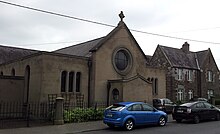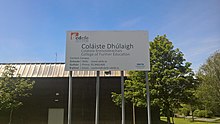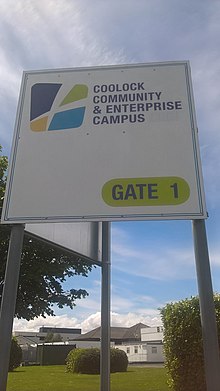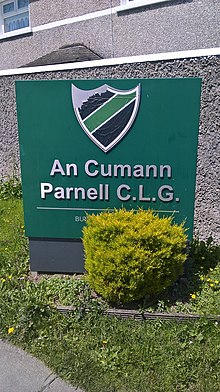Coolock
This articleneeds additional citations forverification.(August 2016) |
Coolock
An Chúlóg | |
|---|---|
Suburb (village core) | |
 Main Street, Coolock village | |
| Coordinates:53°23′17″N6°11′57″W/ 53.3881°N 6.19930°W | |
| Country | Ireland |
| Province | Leinster |
| County | County Dublin |
| Local authority | Dublin City |
| Elevation | 38 m (125 ft) |
Coolock(Irish:An Chúlóg,meaning 'The Little Corner') is a large suburban area, centred on a village, onDublincity'sNorthsideinIreland.Coolock is crossed by theSantry River,a prominent feature in the middle of the district, with a linear park and ponds. The Coolock suburban area encompasses parts of three Dublin postal districts:Dublin 5, Dublin 13 and Dublin 17.
The extensivecivil parishof Coolock takes in the land between the Tonlegee Road (as far asDonaghmede) and the Malahide Road, as well as the lands on either side of the Malahide Road betweenDarndaleandArtane,and the lands either side of the Oscar Traynor Road on the approach toSantry.
Coolockis also the name of thebaronywhich accounts for most of north Dublin city, from the coast as far as Phoenix Park, and stretching north as far as Swords.
History
[edit]Coolock has a history dating back over 3,500 years – aBronze-Ageburial site in the area dates back to 1500 BC. The settlement grew up around a small early-Christian church. A Catholic church, St. John's, was later built in the area (seeParish of Coolock (Roman Catholic)andCoolock parish (Church of Ireland)for more). The feudal barony of Coolock was granted in 1199 by Henry II to theArchbishop of Dublin.
Coolock remained a small village until the 1950s, with lands around the village being further developed over time, notably Bonnybrook andKilmore West,between which a new centre to the area formed. At one time the old village was on the Malahide Road but that road was diverted and now passes slightly to the east of the village; in the meantime, a secondary hamlet, Newtown Coolock, developed further north.
Later again, lands in the north of Coolock were developed to form the new districts of Darndale andPriorswood.
Nature
[edit]Coolock lies on either side of the valley of the Santry River and includes a diversion from the littleNaniken River.It is a relatively flat area a little above sea level, with a linear park around the Santry, and small green areas scattered through residential developments.
Location / character
[edit]
Coolock lies at the centre of the majority working-classNorthsidesuburbs such asKilbarrack,Donaghmede and theEdenmorepart of Raheny, and itself includes localities such as Ayrfield, Bonnybrook, Darndale, Priorswood, Greencastle and Kilmore West. As with other large suburban areas, such asTallaghtorSwords,there is no legal definition for Coolock, and so no definitive population figures, but it is one of Dublin's largest residential areas. It is crossed by the Oscar Traynor Road, running from the Malahide Road to Santry, and named for the War of Independence politician, later long-serving minister,Oscar Traynor.
The majority of Coolock, excluding Ayrfield, was built-up by the then city authority,Dublin Corporation,as part of a programme of the phased inner-cityslum clearance(between, roughly, 1952 and 1987)[citation needed].Dublin City Council calculates[citation needed]that addresses containing "Coolock" comprise the largest stock of local authority houses within its jurisdiction and the area is central to the linear range of local authority building that took place between the 1960s and the 1980s across Dublin's Northside - i.e.Ballymunincluding Poppintree, Kilmore, Coolock, Edenmore,KilbarrackandDonaghmede.
The permanentTravellerhalting siteestates (which differ in layout to traditional halting sites) of Cara Park and Dominick Park, found in the Belcamp area (along the N32) are among the largest halting site facilities provided by local authorities in Ireland. They contain an adult education centre and pre-school facilities for the local Traveller population, both located beside Dominick Park. At least one smaller, more traditional, Traveller settlement is found in the area, close to the Clare Hall Shopping Centre. King of the Travellers, Jim Watt, is a resident of this settlement.
Amenities
[edit]

Public parks in the area include theSantry RiverLinear Park and in Bonnybrook theStardust Memorial Gardenwhich is dedicated to the 48 people who lost their lives in theStardust nightclub.Parnells GAAclub is based in Coolock village.
Coolock is also a centre of local government activity, with aDublin City Councilmajor centre,NEAR FM community radio station,a Health Services Executive centre and a recycling centre.
Localities
[edit]- Ayrfield,an area beginning on the north side of the Tonlegee Road, predominantly within the Dublin 13 postal code, opposite Edenmore, and near Donaghmede and Darndale, containing several estates such as Rathvale, Limewood (part of Dublin 5), Millbrook, Slademore, Foxhill, Greenwood and Ard na Greine. Ayrfield has oneprimary school,St. Pauls Junior and Senior National School. The main access road, Blunden Drive, is the home of Ayrfield Credit Union, Ayrfield Community Centre andO'Tooles GACclubhouse and playing pitches. Ayrfield is also aparishin theHowth deaneryof theRoman Catholic Archdiocese of Dublin.It is served by the Church of St Paul.[1]It is also home to Ayrfield United F.C. which has pitches beside the credit union.
- Belcamp,today comprising some housing between Darndale and Priorswood but historically referring to a broader rural area. It is situated near the site of the former Belcamp Cottage and included cottages demolished to make way for the N32 road. Belcamp Hall, designed by architectJames Hobanis a feature.
- Bonnybrook,a locality within the core of Coolock, above the original village, site of the main shopping centre, and with its own Catholic church and primary school.
- Clonshaugh(Irish:Cluain Seach),[2](now in Dublin 17) stretching from the large Clonshaugh Industrial Estate opposite Kilmore all the way to the AUL, close to Baskin Lane. This includesRiverside,a housing estate at the side of the Santry River, with over 500 residents, first described as being in Santry, but with the postal district changed from Dublin 5 (old main Coolock code) to Dublin 17, andNewbury,situated behind Riverside, accessed from the Clonshaugh Road.
- Darndale,built as a range of social housing estates, east of Clonshaugh and west of Clare Hall. It comprises Buttercup Park, Marigold Court, Primrose Grove, Snowdrop Walk and Tulip Court.
- Greencastle,a locality within the core of Coolock, above the original village.
- Kilmoreas a whole is a large area west of the Malahide Road and east of the M1, where Coolock meets Artane and Beaumont; of this, Kilmore West is entirely within Coolock and includes the sub-locality of Cromcastle, which features numerous multi-storey council flat blocks in the same style as blocks in Kilbarrack.
- Priorswood,a small, densely populated locality found between Belcamp and Clonshaugh, comprising the housing estates of Moatview, Fairfield and Ferrycarrig.
- St. Brendan's Estate,located across the Malahide Road from Coolock village proper, and comprises St. Brendan's Drive, Avenue and Park, Moatfield and Dunree Park.[3]
Located between Donaghmede and Coolock isClare Hall,a later housing estate, which includes a small shopping precinct, and the largeClarehall Shopping Centrewhich is anchored by Tesco Extra.
There are a number of roads named after the1969 Moon landing,including Tranquility Grove (afterTranquility Base), Eagle Park (Lunar Module Eagle), Apollo Way (Apollo 11), Armstrong Walk (Neil Armstrong) and Aldrin Walk (Buzz Aldrin).[4]
Religion
[edit]Coolock has given its name to religious divisions over a long period, and the primary historical ones are discussed atParish of Coolock (Roman Catholic),and (from the Act of Supremacy),Parish of Coolock (Church of Ireland).Both Catholic (multiple) and Church of Ireland buildings stand within the area today. In the Catholic divisions, additional parishes today include Bonnybrook and Ayrfield (encompassing the Greenwood estate).



Education
[edit]- Chanel College,a large boyssecondary schooland adult education source, founded in 1955

- The Donahies Community School, a largesecondary schooland adult education source, founded in 1977
- Coláiste Dhúlaigh Post Primary, Co-ed secondary school in Coolock, located beside Northside Shopping Centre.
- Coláiste Dhúlaigh College of Further Educationprovides third-level courses (QQI, BTEC and FETAC)
- Mercy Collegeis a voluntary, Catholic girls secondary school
- St. Pauls Junior and Senior National School, Ayrfield
- St. Francis, Priorswood
- The now-defunct CatholicBelcamp Collegesecondary schoolin the nearby area of Balgriffin, which operated from 1893–2004


Businesses and retail facilities
[edit]
The outskirts of Coolock host several factories and industrial estates.Cadbury Irelandhas been manufacturing chocolate products since 1957, for both the Irish market and for export.[5][6]The nearbyTayto Crispsfactory manufactured snack foods until it closed in 2005.[7]
Notable retail facilities includeNorthside Shopping Centre,Ireland's first covered shopping centre, situated near accesses to the M1 and M50, with more than 70 outlets and a city council swimming pool.[8]
Popular culture
[edit]Famous historical figures linked to the area includedHenry Grattanof Belcamp Park, and the novelistCharles Lever.
Film and television
[edit]The Coolock area was featured extensively during location shooting for the 1991 filmThe Commitments,directed by Alan Parker and starring a mainly unknown cast at the time.[9]
Transport
[edit]Coolock, which is not crossed by any rail systems, is serviced by main roads, including the N32 and Oscar Traynor Roads which link to the M1, and by the followingDublin Busroutes:
- N6 -KilbarracktoFinglas(Finglas Village)
- 27 -Jobstownto Coolock (Clare Hall Avenue)
- 27A - Coolock (Blunden Drive) toEden Quay[10]
- 27B -Eden QuaytoHarristown
- 27X -Belfield (U.C.D)to Clare Hall Avenue
- 42 - LowerAbbey StreettoMalahideorPortmarnock
- 43 - LowerAbbey StreettoSwords
- 15 -BallycullenRoad toClongriffin[11]
See also
[edit]References
[edit]- ^Official website- Ayrfield parish
- ^"Cluain Seach/Clonshaugh".logainm.ie.Retrieved25 September2022.
- ^"St Brendan's Parish".stbrendanscoolock.org.Retrieved21 January2018.
- ^O'Connor, Amy (24 January 2018)."Double Take: The estate in Coolock named after the 1969 moon landing".TheJournal.ie.Retrieved26 February2022.
- ^"The Story".Cadbury.Retrieved21 January2018.
- ^"Cadbury-owner Mondelez to cut more than 220 Irish jobs in Dublin and Kerry".RTÉ News.26 February 2015.Retrieved21 January2018.
- ^"Tearful Tayto staff call for a halt to outsourcing as city factory closes".Irish Independent.Retrieved21 January2018.
- ^"Northside Shopping Centre".Northside Shopping Centre.Retrieved22 March2018.
- ^"The Commitments - Movie Locations".The Worldwide Guide to Movie Locations.Retrieved22 March2018.
- ^"27a - Dublin Bus".dublinbus.ie.Retrieved21 January2018.
- ^"15 - Dublin Bus".Archived fromthe originalon 21 November 2016.Retrieved21 November2016.

